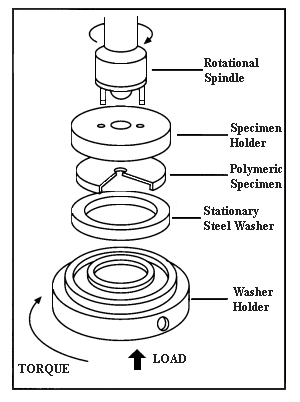Coefficient of Friction Testing of Plastics
The coefficient of friction, or COF, is determined by the ease with which two surfaces slide against each other. The dimensionless value of the coefficient of friction is the ratio of the force required to slide the surfaces to the force perpendicular to the surfaces. A lower friction coefficient indictates that the surfaces are slicker - there is less resistance to the sliding motion. Polymers are usually tested dry (without external lubricant) against polished steel using the thrust washer geometry shown below, from Mitsubishi Chemical Advanced Materials.
 |
ASTM D3702:
A polymeric sample specimen is mated against a steel thrust washer. The test apparatus is rotated and the torque required is measured. Other COF test methods are ASTM D1894 and PTM55007. |
The value obtained for the friction coefficient will depend on both the load (pressure or perpendicular force applied) and the velocity. The friction coefficient is also a function of both surfaces, although polymer testing is almost always tested versus polished steel and result is then reported as an attribute of the polymer for the sake of comparison. No such standard has found popularity in the metals business, because metals are used versus many different surfaces and often are used with surface treatments and/or lubricants in tribological applications.
A distinction should be made between the static COF at the point of incipient motion and the dynamic COF measured at constant velocity. The difference between the static and dynamic COF is known as "slip-stick". Polymers with a low slip-stick are well-suited for parts which undergo back-and-forth or stop-and-go movements.
Fluoropolymers are well-known for their low COF values. One example is Teflon® Polytetrafluoroethylene (PTFE) from DuPont, which is used extensively as a nonstick coating and lubricant. PTFE is mechanically weak, but compounds based on other, intrisically stronger, polymers may incorporate PTFE filler to lower COF values and increase wear resistance, thereby permitting use in bearings or slide plates. Other lubricants used to lower COF and increase wear resistance include silicone, graphite, waxes, and molybdenum disulfide (MoS2). Conversely, plastics are sometimes modified to increase the COF for applications in which added traction or grip is desirable.
